
Hydroelectricity, or hydroelectric power, is electricity produced from hydropower. In 2015, hydropower generated 16.6% of the world's total electricity and 70% of all renewable electricity, and was expected to increase by about 3.1% each year for the next 25 years.

Tarbela Dam is an earth-filled dam along the Indus River in Pakistan's Khyber Pakhtunkhwa province. Located in the Swabi mainly and in some area of Haripur District of the province, The dam is about 30 km (20 mi) from the city of Swabi, 105 km (65 mi) northwest of Islamabad, and 125 km (80 mi) east of Peshawar. It is the largest earth-filled dam in the world. The dam is 143 metres (470 ft) high above the riverbed and its reservoir, Tarbela Lake, has a surface area of approximately 250 square kilometres (97 sq mi).

Run-of-river hydroelectricity (ROR) or run-of-the-river hydroelectricity is a type of hydroelectric generation plant whereby little or no water storage is provided. Run-of-the-river power plants may have no water storage at all or a limited amount of storage, in which case the storage reservoir is referred to as pondage. A plant without pondage is subject to seasonal river flows, thus the plant will operate as an intermittent energy source. Conventional hydro uses reservoirs, which regulate water for flood control, dispatchable electrical power, and the provision of fresh water for agriculture.
According to the International Hydropower Association, Canada is the world's fourth largest producer of hydroelectricity in the world in 2021 after the United States, Brazil, and China. In 2014, Canada consumed the equivalent of 85.7 megatonnes worth of oil of hydroelectricity, 9.8% of worldwide hydroelectric consumption. Furthermore, hydroelectricity accounted for 25.7% of Canada's total energy consumption. It is the third-most consumed energy in Canada behind oil and natural gas.
The Song Loulou Power Station is a hydroelectric power plant of the Sanaga River in Cameroon. It has a power generating capacity of 384 megawatts (515,000 hp) enough to power over 257,100 homes. The Song Loulou power station is built upstream of another power station; the Edea power station. Unlike the Edea power station that mainly power the aluminum smelter located next to it, the Song Loulou power station mainly powers homes and other industrial plants in the South of the country.
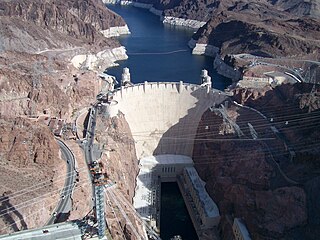
Hydroelectric power in the United States is, as of 2019, the second-largest renewable source of energy in both generation and nominal capacity. In 2019, hydroelectric power produced 38% of the total renewable electricity, and 6.6% of the total U.S. electricity.
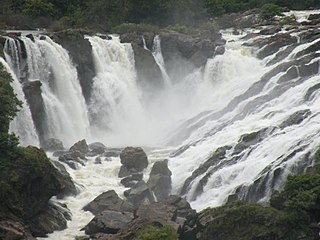
India is 5th globally for installed hydroelectric power capacity. As of 31 March 2020, India's installed utility-scale hydroelectric capacity was 46,000 MW, or 12.3% of its total utility power generation capacity. Additional smaller hydroelectric power units with a total capacity of 4,683 MW have been installed. India's hydroelectric power potential is estimated at 148,700 MW at 60% load factor. In the fiscal year 2019–20, the total hydroelectric power generated in India was 156 TWh with an average capacity factor of 38.71%.
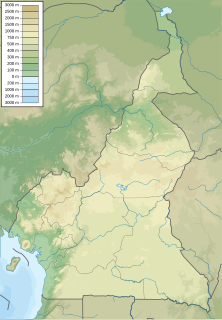
The Lom Pangar Dam is an embankment dam with a center gravity dam section currently under construction on the Lom River about 88 kilometres (55 mi) north of Bertoua in the East Region of Cameroon. It is located about 4 kilometres (2.5 mi) downstream of the Lom River's confluence with the Pangar River and about 13 kilometres (8.1 mi) upstream of where the Lom joins the Sanaga River. The purpose of the dam is to produce hydroelectric power and to regulate water flows along the Sanaga River. It is potentially part of a larger dam cascade on the Sanaga.

The Karot Hydropower Project is an under-construction run-of-river concrete-core rockfill gravity dam in Pakistan, with a planned installed capacity of 720 MW. The project is sponsored by Chinese state-owned company China Three Gorges Corporation (CTG).
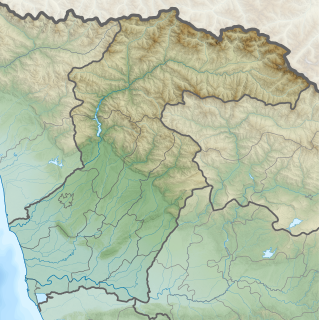
Nenskra Hydro Power Plant is a proposed hydroelectric power station to be located on the southern slopes of the Central Caucasus mountains in Svaneti, Georgia.

Achwa 2 Hydroelectric Power Station is a 41 megawatts (55,000 hp) hydroelectric power plant, in Uganda.
Karura Hydroelectric Power Station, commonly referred to as Karura Power Station, also Karura Dam, is a planned 90 MW hydropower station in Kenya.
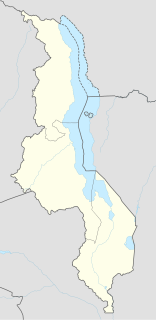
Mpatamanga Hydroelectric Power Station, also Mpatamanga Power Station, is a planned 350 megawatts (470,000 hp) hydroelectric power project to be constructed in Malawi.

Jorethang Loop Hydroelectric project is a 96 megawatts (129,000 hp), run-of-the-river hydroelectric power station on the Rangit river in South Sikkim district of Sikkim state in India. The dam is located near village Piple and power station is located about 13 km downstream near village Majhitar. Dans Energy Private Limited was awarded contract for construction of the project. The project was officially inaugurated on 29 October 2015. The project was built at a cost of Rs 1,182 crores.

Kirkthorpe hydro is a hydroelectric generating plant located on the River Calder at Kirkthorpe Weir, 4 miles (6.4 km) east of the City of Wakefield in West Yorkshire, England. The plant was opened in 2017 and expects to be generating electricity for 100 years. Kirkthorpe Weir is the highest industrial weir in Yorkshire and has prevented fish passing upstream to spawn; the new hydro project has a fish pass built into it.

Sabha Khola Hydropower Station is a run-of-river hydro-electric plant located in Sankhuwasabha District of Nepal. The flow from Sabha River is used to generate 3.3 MW electricity. The plant is owned and developed by Dibyaswari Hydropower P Ltd, an IPP of Nepal. The plant started generating electricity from 2074-06-04BS. The generation licence will expire in 2104-10-03 BS, after which the plant will be handed over to the government. The power station is connected to the national grid and the electricity is sold to Nepal Electricity Authority.

Daraundi A Hydropower Station is a 6 MW run-of-river hydro-electric plant located on the Daraundi River in the Gorkha District of Nepal.

Malagarasi Hydroelectric Power Station, is a planned 50 megawatts (67,000 hp) hydroelectric power station in Tanzania. The development is planned in the Igamba area, west of the Malagarasi swamps, at the site of the Igamba Falls.
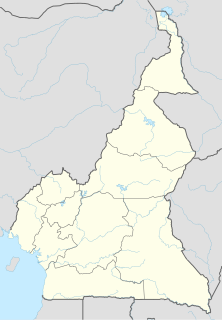
The Nachtigal Hydroelectric Power Station is a 420 megawatts (563,229 hp) hydroelectric power station under development across the Sanaga River that harnesses the energy of the Nachtigal Falls in Cameroon. The development rights were granted to Nachtigal Hydro Power Company (NHPC), a company owned by a consortium comprising (a) Électricité de France (b) International Finance Corporation and (c) the Government of Cameroon. A 35-year power purchase agreement is in place, between Eneo Cameroon S.A. and NHPC.

Kabu 16 Hydroelectric Power Station is a 20 megawatts (27,000 hp) hydroelectric power station under construction in Burundi. It is under development by the government of Burundi, with funding from the Exim Bank of India. Construction began in March 2019.
















